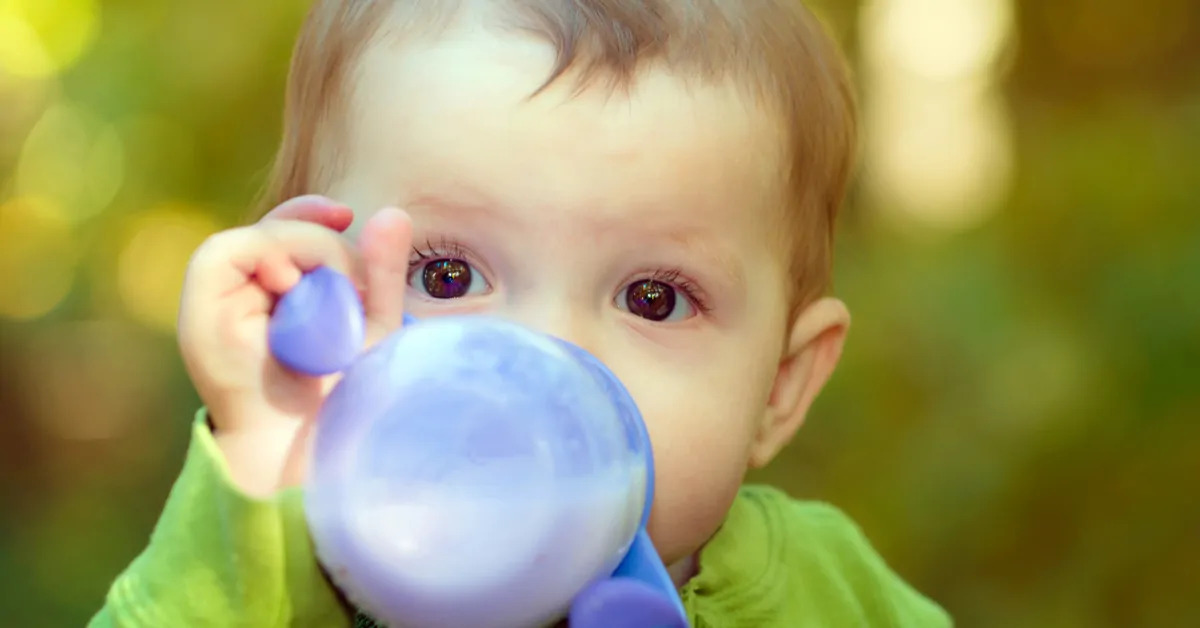
As a pediatrician, I have ALWAYS gotten a lot of questions about (cow’s) milk. What age to start? What kind is best? What if it upsets my baby’s stomach? What if they are allergic? Should I offer it in a bottle or cup? I’ll review my recommendations and how I typically counsel families below. First and foremost: you don’t need a cow to raise a child so if you opt out of cow’s milk, that’s okay, too! However some introduction and feeding of cow’s milk in early life will allow your child a greater chance to tolerate it throughout their life.
Why it’s Important to Introduce Cow’s Milk:
Evolving research in the last 5-10 years proves that introducing allergens to your baby early on is essential to helping lower your little one’s risk of allergies later in life. Cow’s milk is one of the most common food allergies, affecting between 2% and 3% of children younger than 3 years old. While many children may thankfully outgrow a cow’s milk allergy by age 4, this allergy can have a huge impact on your child’s quality of life.
When to Start Your Child On Cow’s Milk:
The American Academy of Pediatrics recommends a combination of solid foods and breastmilk or formula for children under 12 months. Only after 1 year of age do we suggest introducing whole or 2% cow’s milk. Why whole milk? Some parents choose it because of the healthy fat, which helps with brain development, much of which takes place during the first two years of life. However if you’re including fats and cholesterol in your toddler’s diet from other rich foods (cheese, meats, etc) the American Heart Association also suggests you can also choose to serve 2% milk after 1 year of age. Talk with your pediatrician on which to choose, if you want to serve milk to your toddler.
What About Other Dairy Products?
Most babies can begin consuming dairy foods around 6 months of age—after a few first solid foods have been introduced. Plain, whole-fat, or whole greek yogurts can be a good first choice for babies to try. Avoid yogurts with lots of added sugar marketed to babies and toddlers (no need!). If your baby is eating solids well, you can also try cheese. SpoonfulONE is also an easy solution to get dairy included in the diet every day along with 15 other common allergens.
Read Next | These Are the Health Benefits of Butter for Kids
How Much Milk Do Toddlers Need? How Much is TOO much?
As your toddler starts drinking more whole milk, keep in mind milk can really be a small part of their balanced diet. During toddlerhood, most toddlers increasingly take more solid food meals leaving less room for milk. About 8 to 10 ounces is a reasonable minimum of 2% or whole milk consumption (especially if other dairy products are being consumed), and the absolute most a toddler should drink is no more than 16 to 24 ounces of whole milk per day. If your baby seems like they want to drink more than that, try offering increased quantities of solid foods.
Here is a great chart to reference from Healthy Children.
When To Switch From Whole Milk?
If you choose whole milk, your baby can remain on whole milk until they turn 2 (unless instructed by your pediatrician), at which point you should switch to either skim, 1% or 2% milk. No more than 16 ounces of milk a day is recommended after age 2—too much milk can increase iron deficiency because babies eat less of other necessary nutrients when they fill up on milk!
Read Next | Dr. Harvey Karp on the Causes of Baby Constipation & How to Relieve It
What if it Upsets My Baby’s Tummy? What’s the Difference Between a Milk Allergy and Lactose Intolerance?
A milk intolerance and milk allergy are often confused, since both are sensitivities to milk protein, and both share similar symptoms. However, a milk allergy involves the immune system and an intolerance involves the digestive system.
If your baby has a food allergy to milk, it means that their immune system has identified the milk protein as harmful and overreacts. You will know right away or within a couple of hours after feeding if they have an allergy. The most common symptoms of a milk allergy include symptoms within an hour or two of eating:
- Diarrhea
- Vomiting
- Swelling
- Itchiness
- Rashes or hives
- Breathing difficulties
Read Next | How to Keep Kids Safe from Major Springtime Pests
As milk is a widely used ingredient, if your child is allergic to cow’s milk, you’ll want to avoid foods with this ingredient such as cottage cheese, ice cream, yogurt, butter, and powdered milk. Though cow’s milk is the usual cause of a milk allergy, children can also react to milk from other mammals like sheep, goats, or buffalos. Individuals who are allergic to cow’s milk may also be allergic to soy milk, but it is less likely.
Alternatively, babies who are intolerant have an inability to digest lactose into simple sugar. Lactose intolerance does run in families but typically evolves with age — it’s very unusual in infancy. This will also be noticeable within a few minutes or hours of ingesting, but does not include symptoms such as swelling or rashes. Symptoms of intolerance may be similar, and can include:
- Bloating
- Gas
- Diarrhea
- Colic
- Constipation
- Nausea
- Vomiting
If you are unsure if your child is experiencing an allergy or intolerance, visit your pediatrician.

Read Next | This Is Where to Hire an Amazing NYC Nanny
 Dr. Wendy Sue Swanson is a pediatrician, mom to two boys, and the Chief Medical Officer at SpoonfulONE. SpoonfulONE is a line of nutritional products designed to help stop a food allergy before it starts.
Dr. Wendy Sue Swanson is a pediatrician, mom to two boys, and the Chief Medical Officer at SpoonfulONE. SpoonfulONE is a line of nutritional products designed to help stop a food allergy before it starts.
Like what you read? JOIN the Mommybites community to get the latest on FREE online classes, parenting advice, events, childcare listings, casting calls & raffles, and our Parents With Nannies Facebook group. SIGN UP NOW!



